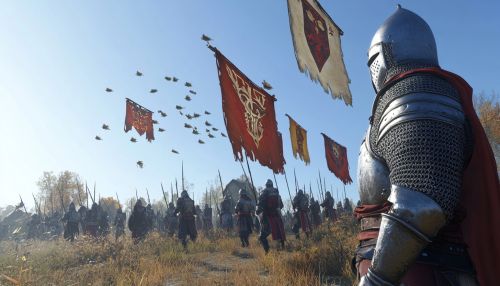Battle of Tewkesbury
Background
The Battle of Tewkesbury, fought on May 4, 1471, was a pivotal engagement in the Wars of the Roses, a series of dynastic conflicts that plagued England during the 15th century. This battle marked a significant turning point in the struggle between the rival houses of Lancaster and York for control of the English throne. The conflict was characterized by a complex interplay of political intrigue, familial alliances, and military strategy.
The Wars of the Roses were rooted in the competing claims to the English crown by the descendants of Edward III. The Lancastrians, represented by the red rose, were led by the reigning King Henry VI and his queen, Margaret of Anjou. The Yorkists, symbolized by the white rose, were led by Edward IV, who had seized the throne in 1461. The Battle of Tewkesbury was a culmination of a series of events that had seen the Yorkists regain power after a brief Lancastrian resurgence.
Prelude to Battle
In the months leading up to Tewkesbury, the political landscape was tumultuous. Edward IV had returned from exile in Burgundy and reclaimed the throne after defeating the Lancastrians at the Battle of Barnet. Queen Margaret, who had been in France, landed in England with her son, Edward of Westminster, Prince of Wales, and a small force, hoping to rally support for the Lancastrian cause.
Margaret's forces moved westward, intending to cross the River Severn and join with Welsh allies. However, Edward IV, demonstrating strategic acumen, intercepted the Lancastrians near Tewkesbury. The Yorkist army, well-rested and better equipped, was prepared to deliver a decisive blow to the Lancastrian hopes.
The Battle
The battlefield at Tewkesbury was strategically chosen by Edward IV. It was a flat, open area, which favored his more experienced and disciplined troops. The Lancastrians, led by the Duke of Somerset and Prince Edward, were forced to adopt a defensive position.
The battle commenced with a ferocious exchange of artillery and archery. The Yorkist forces, commanded by Edward IV and his brother, Richard, Duke of Gloucester, launched a coordinated assault on the Lancastrian lines. The Duke of Somerset attempted a flanking maneuver, but it was thwarted by the Yorkist vanguard.


The Lancastrian forces, outmaneuvered and outnumbered, began to falter. Somerset's troops were driven back, and the Lancastrian center collapsed under the relentless pressure of the Yorkist advance. Prince Edward, the last hope for the Lancastrian cause, was killed in the melee, effectively sealing the fate of his faction.
Aftermath
The victory at Tewkesbury was decisive for the Yorkists. It effectively ended the Lancastrian challenge to Edward IV's reign. In the aftermath, many prominent Lancastrian nobles were captured and executed, including the Duke of Somerset. Queen Margaret was taken prisoner, and King Henry VI, who had been captured earlier, was murdered in the Tower of London shortly thereafter.
The Battle of Tewkesbury solidified Edward IV's position as king and marked the beginning of a period of relative stability in England. The Yorkist victory also paved the way for the eventual rise of the Tudor dynasty, as the remaining Lancastrian supporters rallied around Henry Tudor, who would later become Henry VII.
Military Tactics and Strategy
The Battle of Tewkesbury is notable for its demonstration of military tactics and strategy during the late medieval period. Edward IV's ability to choose the battlefield and his effective use of artillery and infantry coordination were key factors in his victory. The Yorkist forces were well-disciplined, and their ability to execute complex maneuvers under pressure was a testament to their training and leadership.
The Lancastrians, on the other hand, suffered from poor coordination and leadership. The failure of Somerset's flanking maneuver and the collapse of the Lancastrian center were indicative of the challenges faced by an army that was hastily assembled and lacked cohesion.
Legacy
The Battle of Tewkesbury has been studied extensively by historians and military scholars. It represents a critical moment in the Wars of the Roses and provides insight into the political and military dynamics of the period. The battle's outcome had far-reaching implications for the future of England, influencing the course of the Tudor dynasty and the eventual unification of the English crown.
The battlefield itself has been preserved as a historical site, attracting visitors and scholars interested in exploring the events of 1471. The battle is commemorated annually with reenactments and educational programs that highlight its significance in English history.
